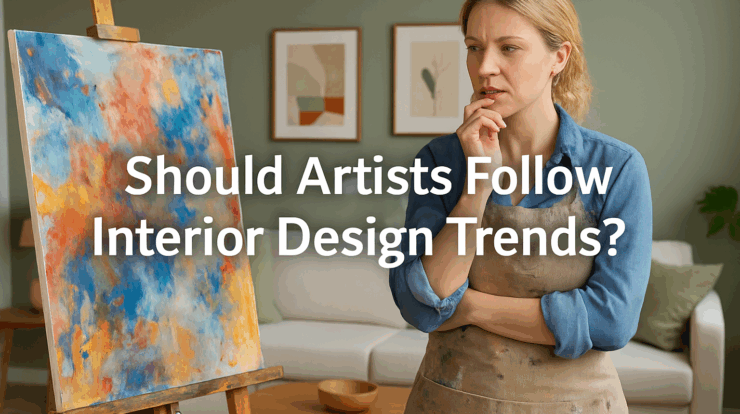
Every so often a color “of the year” sweeps across social feeds, showrooms, and design magazines. It’s tempting to steer your studio to match. After all, if buyers are asking for sage green walls and airy minimalism, shouldn’t your palette follow suit?
Short answer: be aware of trends, but don’t let them steer the ship. Your long-term career is built on distinctive, consistent work—not on chasing a moving target.
 The Problem with Small Samples
The Problem with Small Samples
What feels like a “trend” is often a tiny slice of data:
-
Two recent buyers loved neutral palettes.
-
A designer asked whether you had softer pastels.
-
A slow month coincided with a bold color series.
Those observations are real, but they’re anecdotal. With small numbers, randomness looks like a pattern. Pivoting your whole body of work on small samples risks whiplash—confusing buyers, diluting your style, and slowing momentum.
Rule of thumb: when you think you see a pattern, ask, “How many data points do I have, over how many months, and in how many venues?” If the answer is “not many,” keep creating what you create.
Trends vs. Timeless
Interior design cycles move faster than fine art careers. A wall color can change in a weekend; a collector’s relationship with artwork lasts decades. Collectors buy the emotional experience of a piece, not a Pantone code.
Trends can inform presentation—framing choices, how you style a room shot, or which pieces you spotlight in a newsletter. They shouldn’t override your core visual language.
What to Watch (Without Overreacting)
-
Color waves: If a color family is everywhere, consider curating a few pieces that harmonize for promotional images. You’re not repainting your portfolio; you’re showing how your existing work lives in current spaces.
-
Scale and spacing: Open-plan rooms may favor larger works; tight urban homes may lean on diptychs or verticals. Adjust inventory mix—not your identity.
-
Subject matter emphasis: If your range includes both traditional and abstract, you might surface more of the side that aligns with what’s moving right now. You’re curating, not reinventing.
Build Feedback Loops (Real Ones)
Instead of guessing, set up lightweight ways to gather meaningful input:
-
Gallery partner reports: Ask for monthly notes on what’s getting tried on walls, what’s being held, and what closes.
-
Short collector surveys: A polite, 2–3 question email after a show can reveal why someone purchased (or didn’t).
-
Analytics with context: Track views and time-on-page for specific works, but correlate with in-person conversations and inquiries. Online behavior alone can mislead.
Look for converging signals over at least a quarter before declaring a trend relevant to you.
Protect Your Style with Guardrails
-
Consistency first: Keep your signature elements (mark-making, composition, finish) stable across series.
-
Experiment at the edges: Use small studies or a limited sub-series to explore a trend-informed palette or texture. If it resonates, fold aspects into your main line gradually.
-
Name the experiment: Label it as a distinct series so galleries and collectors understand where it fits.
A Simple Decision Framework
Before altering your work to match a design wave, check three boxes:
-
Fit: Does the change align with your authentic voice?
-
Signal strength: Do you have multiple, recent, cross-venue signals (not just a couple of comments)?
-
Sustainability: Can you reproduce the change consistently across new pieces without derailing production?
If any answer is “no,” adjust curation and presentation—not the artwork.
Smart Ways to Meet the Market (Without Shape-Shifting)
-
Photograph in context: Stage room shots that reflect current interiors so buyers can imagine your work at home—even if the palette is bold or unconventional.
-
Offer variety by selection, not reinvention: If you already create both quiet and vibrant pieces, modulate what you send to each venue based on their audience.
-
Use framing and finishes: Contemporary float frames, matting choices, or edge treatments can bridge different interiors while protecting the core of the piece.
The Bottom Line
Design trends can be useful signals, but they’re not steering commands. Track them, learn from them, and use them to curate how you present your work. Meanwhile, keep creating the art you’re passionate about—the work that carries your voice forward year after year. That’s what builds collector trust, gallery confidence, and a durable career.
